How to Mine Kaspa with ASIC and GPU: Settings, Extra Rewards, Dual Mining
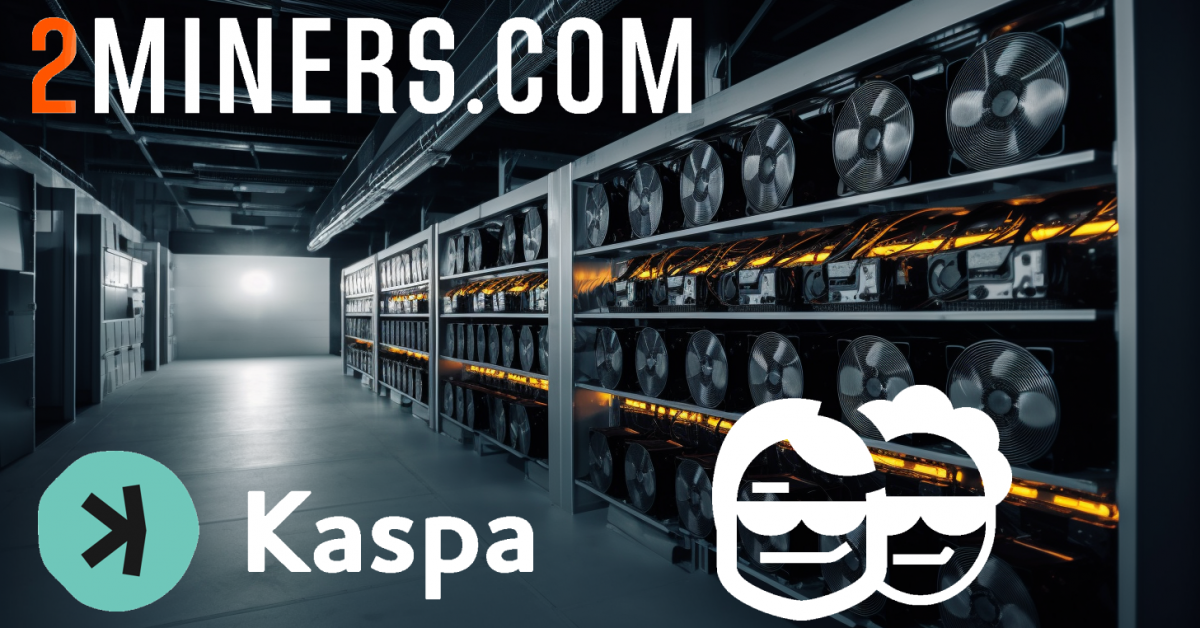
Introduction to Kaspa Cryptocurrency
Kaspa is a unique hybrid cryptocurrency that combines features of both Bitcoin and Ethereum-like blockchains. Its primary innovation lies in its approach to organizing blocks, which relies on a Directed Acyclic Graph (DAG) structure instead of a linear chain. In Kaspa, multiple blocks can be generated simultaneously, allowing for faster transaction processing and higher throughput compared to traditional blockchains.
One of the key differences between Kaspa and other cryptocurrencies is its block generation rate. Kaspa aims to produce a new block every second, resulting in a much higher frequency of blocks compared to most other cryptocurrencies. This rapid block generation is enabled by the GHOSTDAG protocol, which helps maintain the consistency and security of the network despite its non-linear structure. Use Kaspa Visualizer to visually understand how is it done.
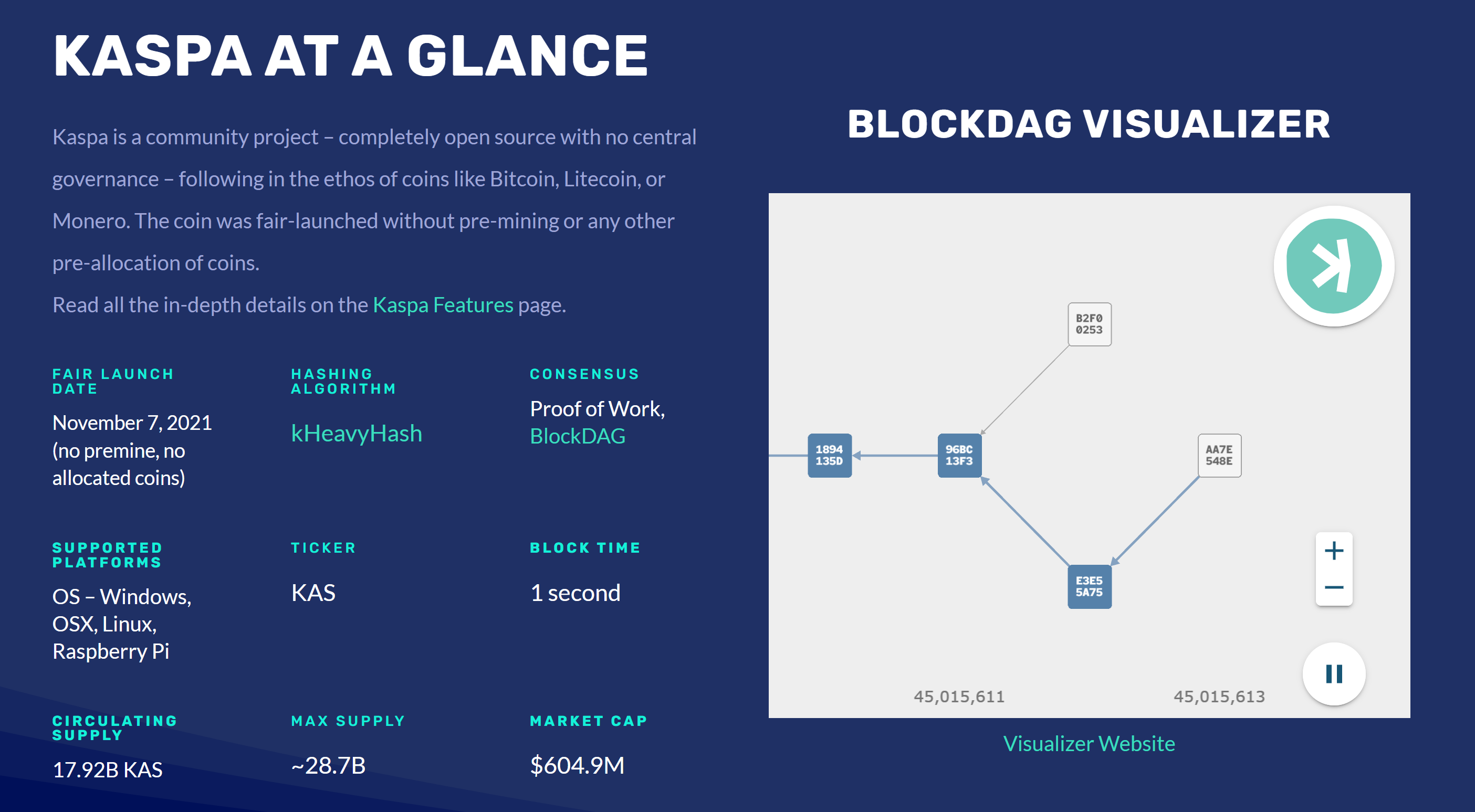
Kaspa’s block rewards are also unique, as they are paid retroactively to the addresses of the blocks being pointed to, rather than directly to the miner’s address. Additionally, when a block points to a “red” (poorly connected) block, the block reward goes to the miner instead. This incentivizes miners to merge poorly connected blocks, improving the overall connectivity of the network.
Furthermore, Kaspa employs a custom-built mining algorithm called KHeavyhash, which is designed for GPU mining, allowing for dual mining of Kaspa and other cryptocurrencies relying on memory-intensive mining algorithms. However, the recent introduction of ASIC devices in the network could impact the mining landscape and centralization risks.
Why Choose 2Miners Mining Pool for Kaspa
When it comes to mining Kaspa, selecting the right mining pool can significantly impact your overall mining experience and profitability. 2Miners mining pool is a top choice for Kaspa miners due to its numerous advantages, professional service, and commitment to transparency. By choosing 2Miners, you gain access to dedicated powerful servers, low latency internet connection, reliable connections to other nodes, and a hassle-free mining environment.
2Miners set the special port for ASIC devices. It ensures the best performance of your machines and reduces internet traffic significantly.
Mining with a Pool is More Secure
Kaspa features a very rapid block generation rate. A new block is created every 1 second on average. That means 86 400 blocks are created daily. Nearly all the miners, especially in the first days of Kaspa mining chose to mine alone using their own Kaspa cryptocurrency node. Thanks to the Kaspa developers that process is not much complicated. With the growth of the KAS network, many miners opted for the mining pools. 2Miners provides not only the collective PPLNS pool for Kaspa but also the SOLO pool. A PPLNS pool gives the possibility for the rig owners to team up and mine together. This helps to get much more stable rewards. And what about the SOLO pools? Why should a miner choose a SOLO pool and not mine to its own node?

You could find the detailed answer in our post Crypto Mythbusters: Solo Mining Pools Are Useless. In short, the SOLO mining pool provides you the better mining performance and at the end of the day, you get more coins compared to SOLO mining to your own node. You pay the small pool fee of 1-1.5% but you get a whole bunch of advantages. Opting for a SOLO mining pool like 2Miners ensures a more secure mining experience compared to running your own cryptocurrency node. With 2Miners, you benefit from a dedicated and powerful server, backed up by separate nodes for major cryptocurrency pools. Furthermore, 2Miners specialists constantly monitor upgrades for cryptocurrency nodes, ensuring you’re always using the latest and most secure version. This eliminates the need for you to spend time on updates and setups, providing a more stable and secure mining experience. On 2Miners you get detailed statistics including hashrate, shares, rewards, and more. You also get notifications by email or using the Telegram bot whenever your rigs go offline or a new block is found.
One of the key reasons to choose 2Miners for Kaspa mining is its commitment to paying out the full block rewards, including any extra rewards. Unlike many other mining pools, 2Miners does not keep the additional 233 KAS when block rewards are doubled. Instead, they ensure that miners receive the full amount they’ve earned. This transparency and dedication to fair payouts make 2Miners an ideal choice for miners looking to maximize their rewards from Kaspa mining.
In the screenshot below you see the block rewards being always paid in full.
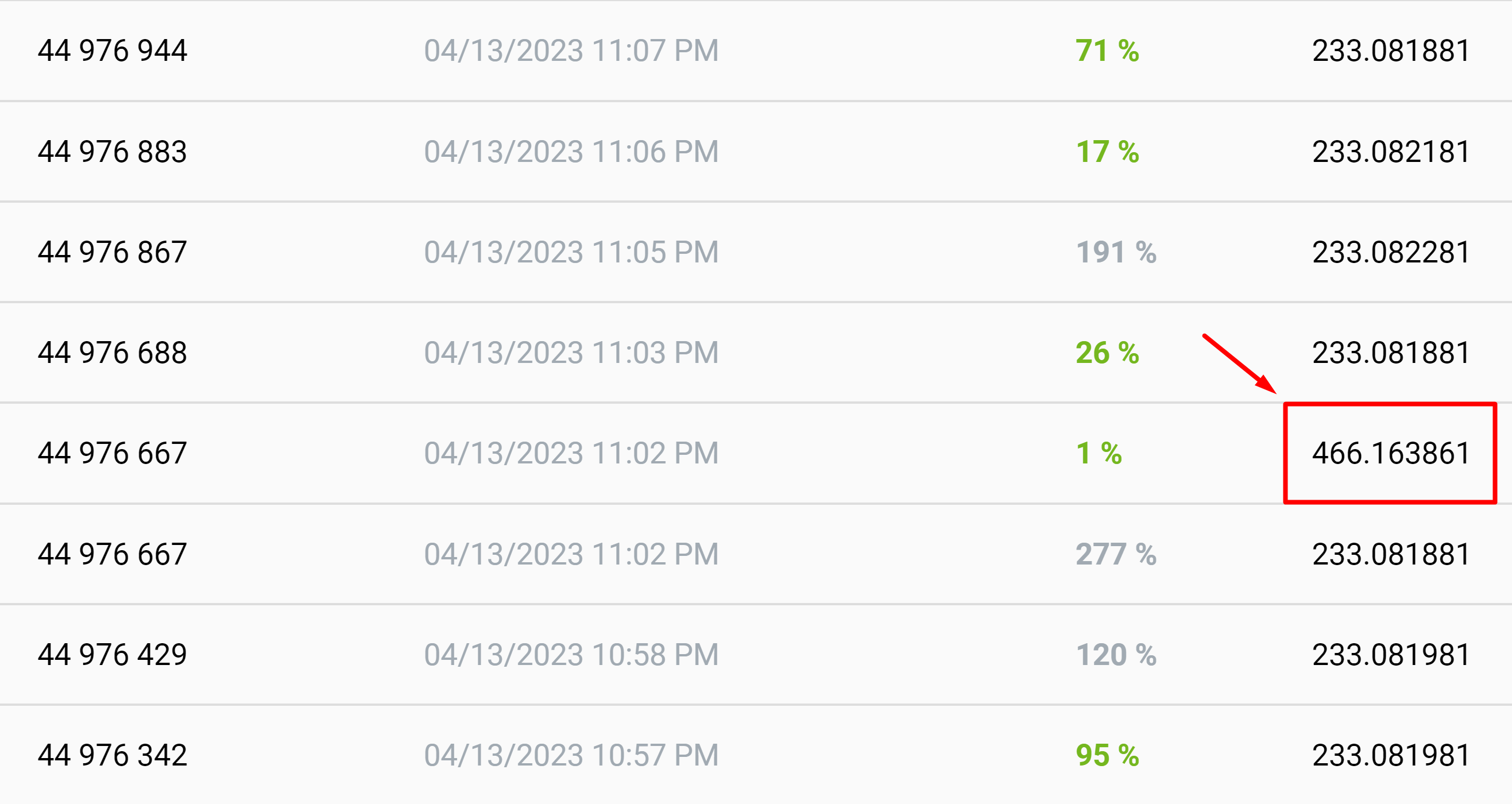
Mine KAS and Get BTC Payouts
Besides using a Kaspa wallet, 2Miners pool offers you the option to utilize any Bitcoin wallet for your mining endeavors. When mining coins such as ZEC, ETC, RVN, ERG, KAS, and NEXA, 2Miners enables miners to receive payouts directly in BTC. To leverage this facility, input your BTC wallet address into your mining software settings, replacing the standard Kaspa wallet address. We support all Bitcoin address formats: SegWit, Compatibility, and Legacy. Plus, BTC addresses set up on cryptocurrency exchanges are equally suitable, providing miners with added convenience and flexibility in managing their mining earnings.
How to Set Up ASIC for KAS
To set up your ASIC device for KAS mining on 2Miners, follow these simple steps to ensure a smooth and efficient mining experience. The 2Miners pool has dedicated ports for ASIC mining, with a 3434 port on the SOLO pool and a 2222 port on the PPLNS pool. These ports have a share difficulty of 17.59T, and the pool has been thoroughly tested and optimized to minimize invalid shares for ASIC devices. The chart below shows the number of invalid shares before and after the special port was introduced on 2Miners. As you see the difference is huge.
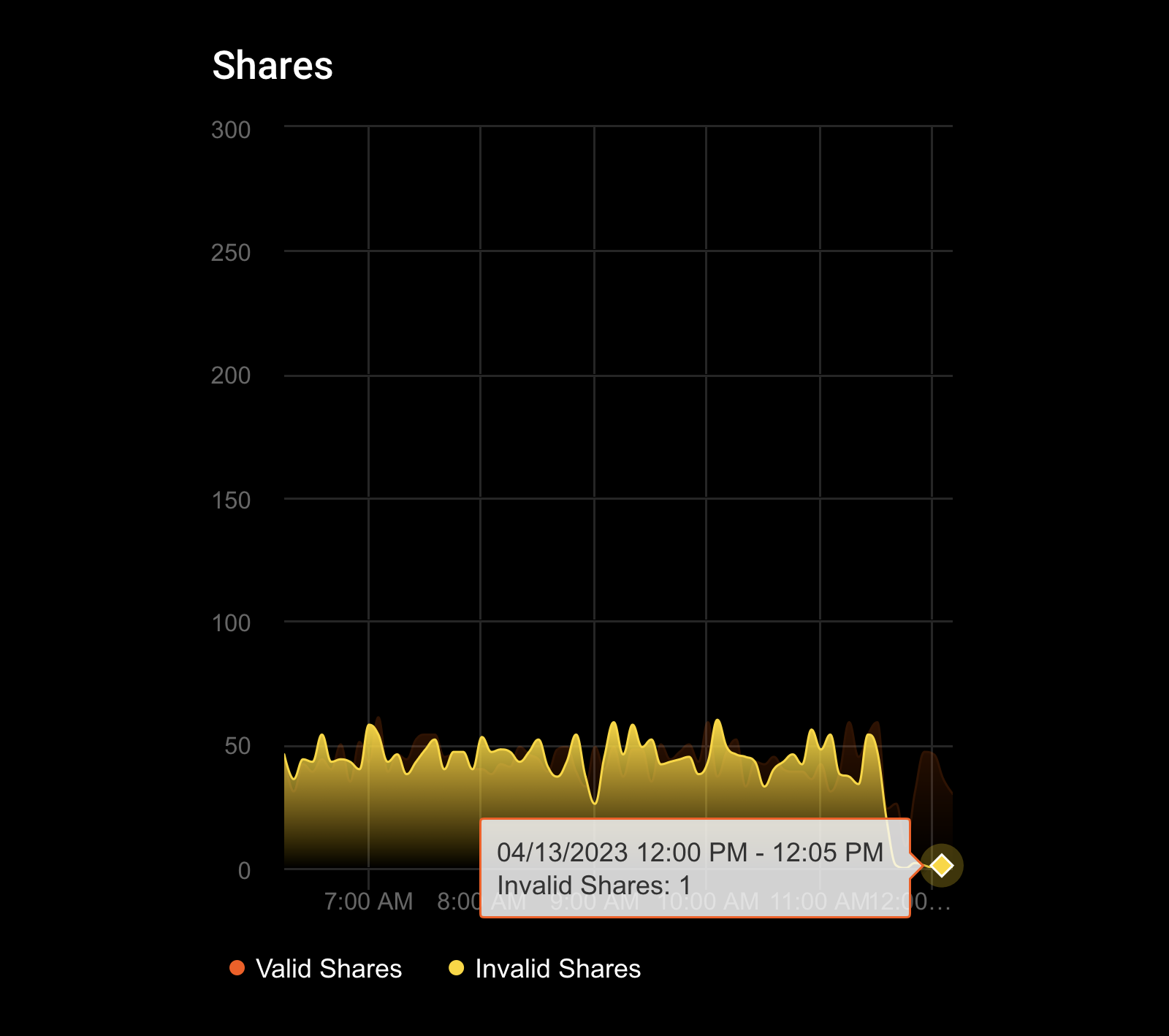
First, select the appropriate pool: either the SOLO pool for those who prefer to mine without sharing rewards or the PPLNS pool for a more traditional mining experience. You could estimate your rewards and the blocks you could get in SOLO mode using 2CryptoCalc KAS page. We recommend going to the SOLO KAS mining pool only if you get at least 1-2 blocks a day. If you see a smaller value according to your hashrate you’d better opt for the PPLNS KAS pool.

Configure your ASIC device’s mining software with the appropriate pool URL.For SOLO pool: stratum+tcp://solo-kas.2miners.com:3434
For PPLNS pool: stratum+tcp://kas.2miners.com:2222
Set your worker’s username to your Kaspa wallet address, which should follow this format. kaspa:qzd6sfx3a8gx3q0qjvsts0pc4gj62z8a4kdf6qcndq5fg42wwxpv6sv9ngmg9
You could use a Bitcoin wallet address instead as well, for example.bc1qnkyhslv83yyp0q0suxw0uj3lg9drgqq9c0auzc
Use ‘x’ as the password for your worker.
Save your ASIC device’s mining configuration and restart the device if necessary. Monitor your mining device’s performance on the 2Miners dashboard, where you can track your hashrate, luck, found blocks, and payouts. To view your statistics just enter your Kaspa wallet address in the search field at the top of the website. Take advantage of the free notifications provided by 2Miners for newly found blocks and rig shutdowns via email or Telegram.
IceRiver KAS KS1 and IceRiver KAS KS2 ASIC for Kaspa Mining
IceRiver is the first manufacturer that releases the ASICs for the KHeavyHash mining algorithm which is used exclusively by the Kaspa network.
The IceRiver KAS KS2 is priced at $29,900.00 and offers a mining capacity of 2TH/s (±10%), with a power consumption of 1200W (±10%). This powerful ASIC device provides an efficient solution for miners looking to maximize their Kaspa mining capabilities.
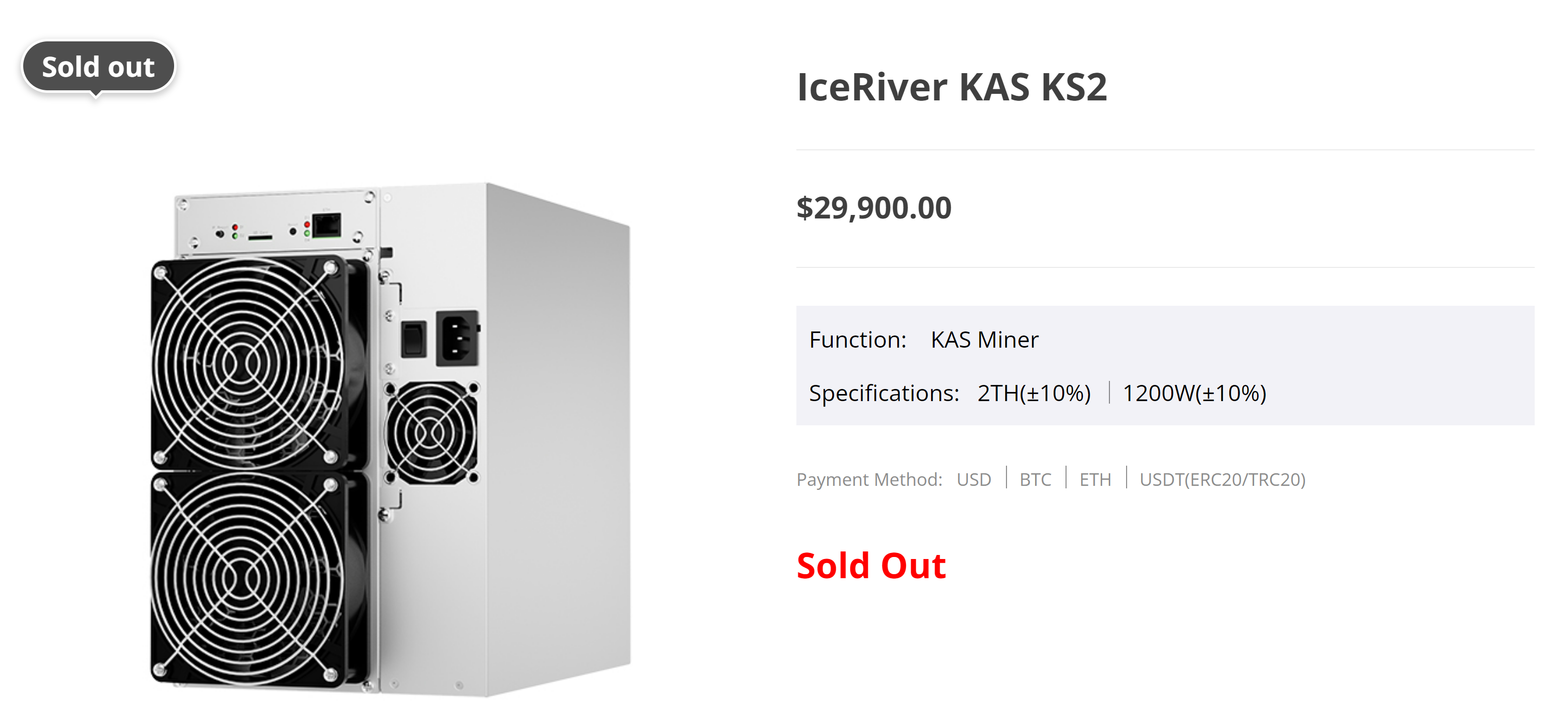
On the other hand, the IceRiver KAS KS1 is available for $15,900.00 and features a mining capacity of 1TH/s (±10%) with a power consumption of 600W (±10%). This more affordable option still delivers impressive mining performance, making it suitable for those who want to enter the Kaspa mining market with a lower initial investment.
Both the IceRiver KAS KS2 and KS1 devices are dedicated to mining Kaspa exclusively, ensuring that users can take full advantage of the rapidly growing Kaspa network and its unique features. With the introduction of these ASIC devices, Kaspa mining is becoming increasingly competitive, and miners can expect more advanced hardware options to emerge in the future.
IceRiver KAS KS1 and KS2 Profitability
Let’s calculate the profitability of IceRiver KAS KS2 using the 2CryptoCalc mining calculator. The KS2 hashrate is equivalent to 3,000 Nvidia 3070 GPUs, this powerful device demonstrates remarkable mining performance. Using the 2CryptoCalc profitability calculator, we can approximate the potential earnings for this device, considering the current rewards and network hashrate.
- Hour: 1,687 KAS ($56.73)
- Day: 40,498 KAS ($361.58)
- Week: 283,488 KAS ($9,531.07)
- 30 Days: 1,214,949 KAS ($40,847.46)
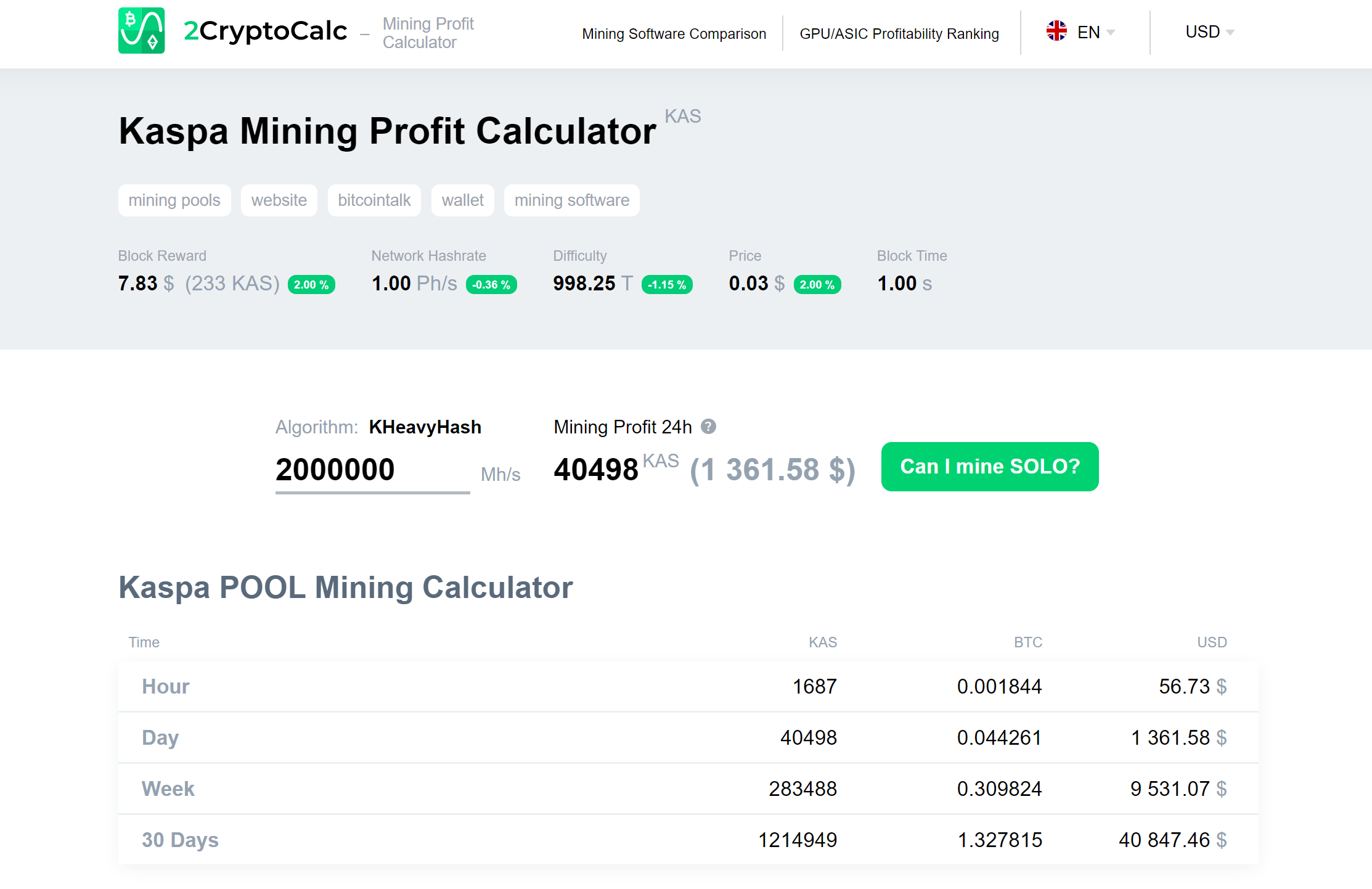
It currently takes around 3 weeks to recover the initial investment for this ASIC device, but this timeframe may extend as the Kaspa network evolves. It’s crucial to keep in mind that these estimates are subject to change as the network hashrate grows and rewards potentially decrease in the future.
One possible challenge with using the IceRiver KAS KS2 is the increasing network hashrate, which could result in lower mining rewards over time. Additionally, as more miners join the network and adopt powerful ASIC devices like the KS2, the mining difficulty is likely to increase, impacting the device’s profitability.
Settings for IceRiver KAS KS0, KS1, KS2, KS3 and KS3L ASIC Miners
The settings are quite straightforward. They could be always found on the help page of the Kaspa PPLNS pool and SOLO pool. Always use the special port for your ASIC. Please note that it is recommended to use different ports for a high-end KAS miners like KS3 or KS3L and low-performance models such as KS0.

You could find the basic connection parameters below. Remember that you could use both your Kaspa wallet address or the Bitcoin wallet address as the login.
SOLOURL: stratum+tcp://solo-kas.2miners.com:3434
Worker: kaspa:qzd6sfx3a8gx3q0qjvsts0pc4gj62z8a4kdf6qcndq5fg42wwxpv6sv9ngmg9
Password: x
POOLURL: stratum+tcp://kas.2miners.com:2222
Worker: kaspa:qzd6sfx3a8gx3q0qjvsts0pc4gj62z8a4kdf6qcndq5fg42wwxpv6sv9ngmg9
Password: x
How to Set Up GPU for KAS
Kaspa has been one of the most profitable coins for GPU mining, attracting many miners to its network. Its unique mining algorithm and rapid block generation have allowed GPU miners to obtain significant rewards. However, the recent emergence of ASIC devices designed specifically for Kaspa mining could disrupt this landscape.
The introduction of ASICs, like the IceRiver KAS KS1 and KS2, into the Kaspa network may have a substantial impact on GPU miners. As these powerful devices flood the network, the mining difficulty is expected to rise, leading to reduced rewards for individual miners. Consequently, GPU miners, who previously enjoyed considerable earnings, could face dwindling returns.
Despite this impending shift, it is still possible to mine KAS using GPUs and receive substantial rewards. However, the window for profitable GPU mining may be closing as more ASICs join the network. GPU miners should be prepared for the potential decrease in profitability and consider diversifying their mining activities or upgrading their hardware to remain competitive.
Currently, Kaspa is still one of the Top coins in terms of profitability for many GPUs. Please find below the most profitable coins for Nvidia 3070 (The calculations were done for 300x Nvidia 3070 GPUs).
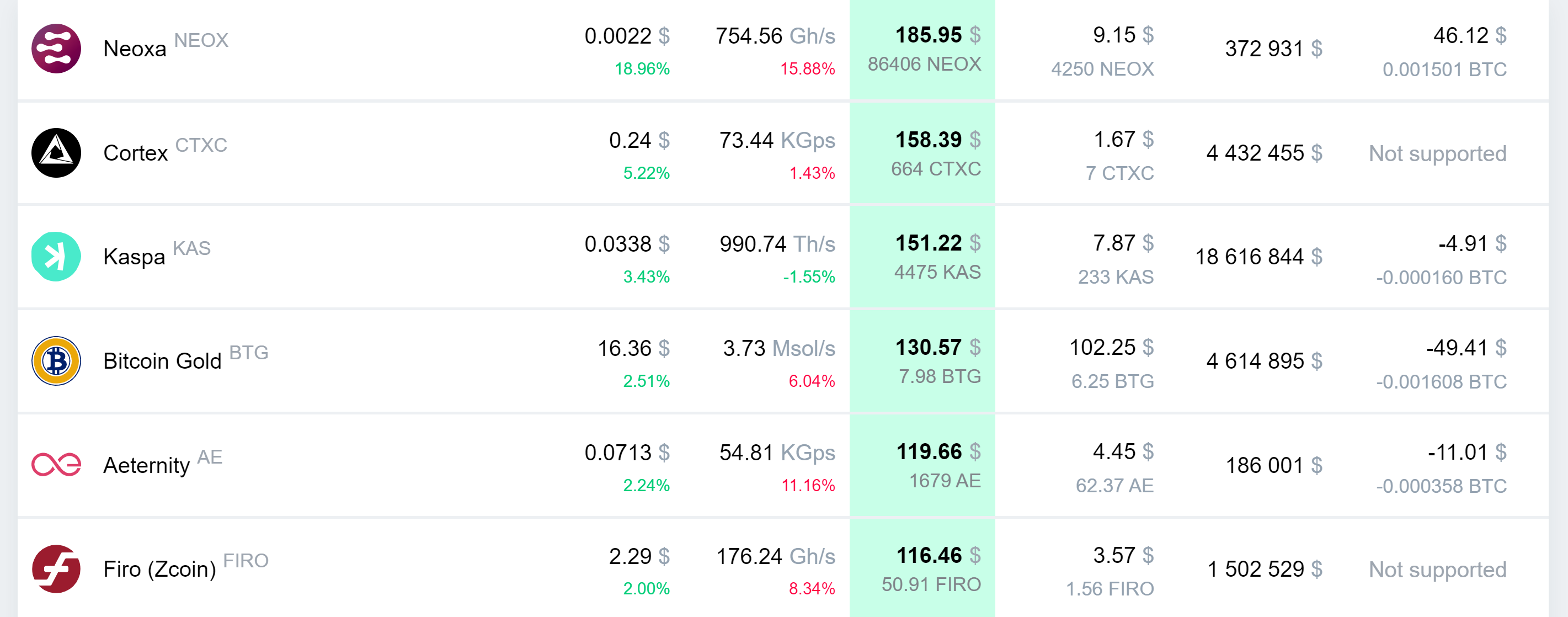
Remember that it is always important to mine the most profitable coin. 2CryptoCalc.com helps you to find it for your hardware.
You could always find the settings for Kaspa mining on the Help page. We also have the ready-to-go bat files in our Quick Start Archive.
Please find below the settings for Kaspa Mining the most popular mining software. Use your Kaspa wallet address instead of YOUR_WALLET_ADDRESS. For example kaspa:qzd6sfx3a8gx3q0qjvsts0pc4gj62z8a4kdf6qcndq5fg42wwxpv6sv9ngmg9 or bc1qnkyhslv83yyp0q0suxw0uj3lg9drgqq9c0auzc. If you want, you can change RIG_ID in the bat file. Specify the name of the rig as you want it to be shown on the miner’s statistics page. This field is not mandatory. You could leave it empty. Length of RIG_ID – Maximum 32 characters. Use English letters, numbers, and symbols “-” and “_”. Example: rig-1
Settings to Mine Kaspa with Gminer
miner.exe --algo kheavyhash --server kas.2miners.com:2020 --user YOUR_WALLET_ADDRESS.RIG_ID
Settings to Mine Kaspa with lolMiner
lolMiner.exe --algo KASPA --pool kas.2miners.com:2020 --user YOUR_WALLET_ADDRESS.RIG_ID
Settings to Mine Kaspa with Team Red Miner
teamredminer.exe -a kas -o stratum+tcp://kas.2miners.com:2020 -u YOUR_WALLET_ADDRESS.RIG_ID
Settings to Mine Kaspa with Rigel
rigel.exe -a kheavyhash -o stratum+tcp://kas.2miners.com:2020 -u YOUR_WALLET_ADDRESS -w RIG_ID
Kaspa Dual Mining
Dual mining has become a popular choice for many miners, particularly in the case of Kaspa, where it is possible to mine two coins simultaneously with a single GPU. The most common combinations for dual mining with Kaspa are Ethereum Classic (ETC) and Ergo (ERG). This approach can lead to increased power consumption, but with the right settings and adjustments, miners can optimize their rigs for maximum efficiency.
When engaging in dual mining, both ETC/ERG and Kaspa can be mined effectively without compromising the mining efficiency of either coin. In some cases, dual mining can achieve more than 95% efficiency for ETC or ERG mining compared to mining these coins individually, while still maintaining up to 70% efficiency for Kaspa mining.
To optimize dual mining, miners should carefully consider their GPU settings, power consumption, and potential earnings for both coins. It is crucial to balance the mining intensity and power consumption of the rig to avoid any negative impact on the overall mining performance.
One option to achieve optimal results is to use mining software that supports dual mining and allows users to configure the settings for each coin separately. This way, miners can fine-tune their GPUs for maximum efficiency and profitability.
Kaspa Dual Mining with Nvidia 3070
We made some tests with the mining rig made of Nvidia 3070 GPUs. We mined separately Kaspa (KAS), Ethereum Classic (ETC), and Ergo (ERG) and then dual mining combinations such as Ethereum Classic + Kaspa and Ergo + Kaspa. For each of the tests, we checked the maximum possible stable hashing rate for the GPUs. Please find the results below.
- Ergo: 172.4 MH/s
- Ethereum Classic: 61.1 MH/s
- Kaspa: 740.2 MH/s
- Ethereum Classic + Kaspa: 60.4 MH/s for ETC + 543.9 MH/s for KAS
- Ergo + Kaspa: 167.5 MH/s for ERG + 502.7 MH/s for KAS
The screenshot displaying ETC + KAS dual mining results highlights the potential for impressive hashrates when mining both coins simultaneously. Although the settings used in this experiment may not be optimal for energy consumption, the achieved hashrates emphasize the possibilities of dual mining as a way to maximize the use of a single GPU.
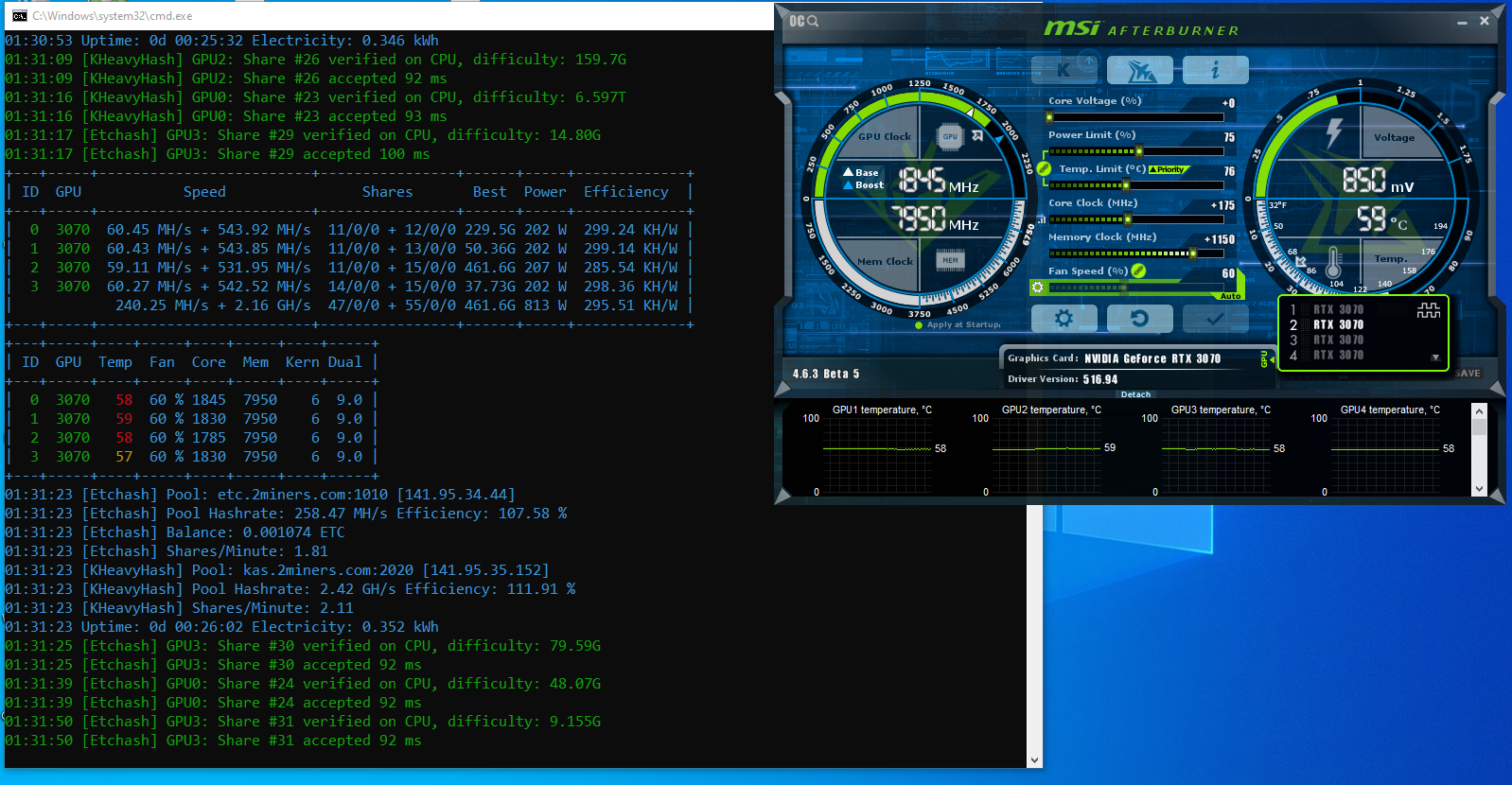
In this scenario, it’s as if one Nvidia 3070 GPU is mining Ethereum Classic, while another one is mining Kaspa. This “doubling your GPU” concept shows how dual mining can significantly enhance mining efficiency and profitability. By effectively utilizing the GPU’s resources for mining two coins, miners can increase their overall earnings without having to invest in additional hardware.
However, it’s important to note that to fully optimize this dual mining approach, miners should carefully consider their energy consumption and adjust their settings accordingly. Achieving a balance between high hashrates and reasonable power consumption is crucial for long-term mining sustainability and profitability.
Ethereum Classic + Kaspa Dual Mining Settings
Here’s an example of a bat file for Gminer that you can use for dual mining Kaspa (KAS) and Ethereum Classic (ETC). Please make sure to replace the example wallet addresses with your own. For ETC you could use either Ethereum Classic or Bitcoin address. For Kaspa you could use either Kaspa or Bitcoin address. You could receive payouts in BTC for mining both coins (ETC and KAS).miner.exe --algo etchash --server etc.2miners.com:1010 --user 0xa6e43E5D497ce1f4d28b4270630E97308eDA8b3e --dalgo kheavyhash --dserver kas.2miners.com:2020 --duser kaspa:qzc3wdqk58t7s9049p3nhz8l2hu6ru6mta6adeuz688xu7g3k7ph2f38z2gu8
for lolMinerlolMiner.exe --algo ETCHASH --pool etc.2miners.com:1010 --user 0xa6e43E5D497ce1f4d28b4270630E97308eDA8b3e --dualmode KASPADUAL --dualpool kas.2miners.com:2020 --dualuser kaspa:qzc3wdqk58t7s9049p3nhz8l2hu6ru6mta6adeuz688xu7g3k7ph2f38z2gu8
Ergo + Kaspa Dual Mining Settings
Here’s an example of a bat file for Gminer that you can use for dual mining Kaspa (KAS) and Ergo (ERG). Please make sure to replace the example wallet addresses with your own. For ERG you could use either Ergo or Bitcoin address. For Kaspa you could use either Kaspa or Bitcoin address.miner.exe --algo autolykos2 --server erg.2miners.com:8888 --user 9hcksqJGwwYP6hwxzs6fAqfu3Qdi7YdHoK9GrUxpYhNDeFCZrPh --dalgo kheavyhash --dserver kas.2miners.com:2020 --duser kaspa:qzc3wdqk58t7s9049p3nhz8l2hu6ru6mta6adeuz688xu7g3k7ph2f38z2gu8
for lolMinerlolMiner.exe --algo AUTOLYKOS2 --pool erg.2miners.com:8888 --user 9hcksqJGwwYP6hwxzs6fAqfu3Qdi7YdHoK9GrUxpYhNDeFCZrPh --dualmode KASPADUAL --dualpool kas.2miners.com:2020 --dualuser kaspa:qzc3wdqk58t7s9049p3nhz8l2hu6ru6mta6adeuz688xu7g3k7ph2f38z2gu8
Kaspa Mining with FPGA
FPGA (Field-Programmable Gate Array) devices are now being used for Kaspa mining, as Kaspa is currently the most profitable coin for FPGA among all the coins available. FPGAs are programmable semiconductor devices that can be reconfigured for various tasks, usually making them faster and more efficient than graphics cards. FPGAs are more flexible than ASICs as they could be modified and reprogrammed for different mining algorithms.
Some popular FPGA devices used for Kaspa mining include BittWare CVP-13, Xilinx Varium C1100, U50C, ECU50, E300, E335C, VCU1525, TUL TH55 and TH53, Aleo U200, and SQRL Forest Kitten 33. According to the hashrate.no calculations, the estimated ROI for these devices ranges from 502 days for the Xilinx U50C to 1744 days for the SQRL Forest Kitten 33.
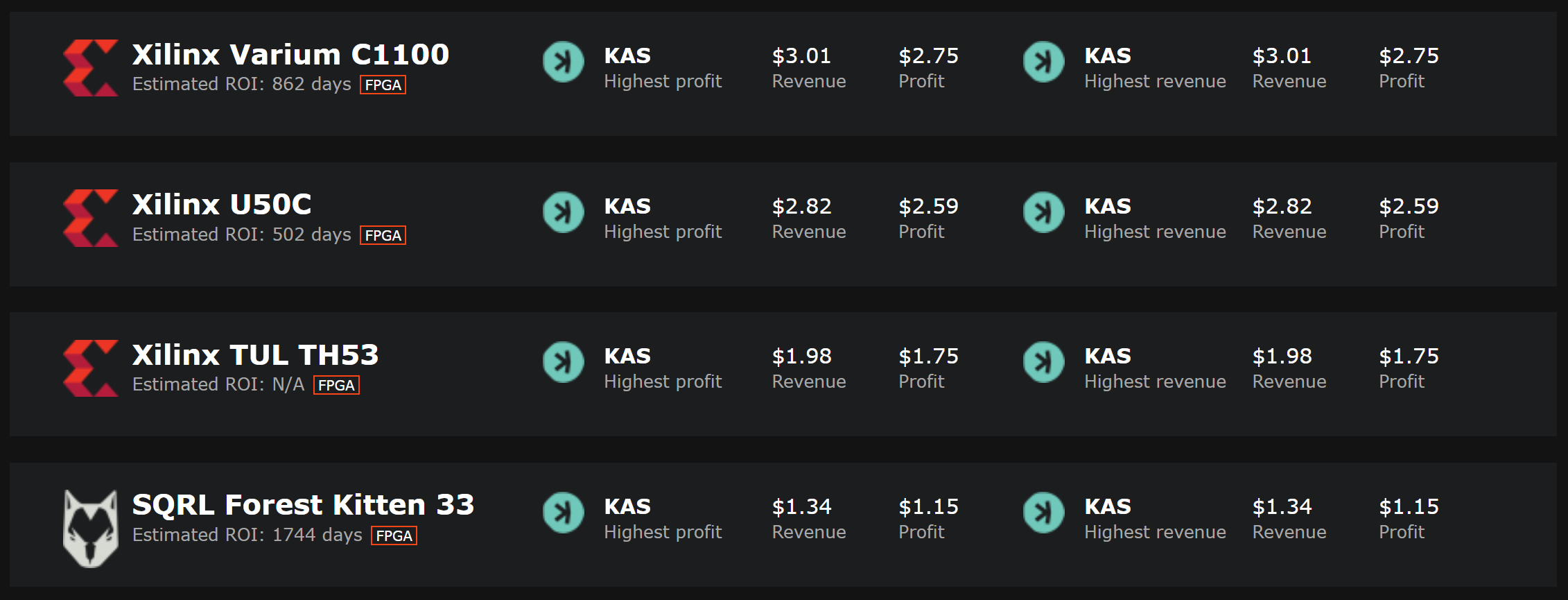
To mine Kaspa using FPGA devices, the teamredminer software is recommended. A detailed guide on setting up the FPGA for mining can be found at teamredminer’s documentation. The basic setup for teamredminer could be found below.
teamredminer.exe -a kas -o stratum+tcp://kas.2miners.com:2020 -u kaspa:qzc3wdqk58t7s9049p3nhz8l2hu6ru6mta6adeuz688xu7g3k7ph2f38z2gu8 -p x
Keep in mind that configuring FPGA settings can be complex, so it’s essential to follow the instructions carefully. For additional support, you can refer to this video tutorial that provides step-by-step guidance on configuring your FPGA device for Kaspa mining.
FPGA devices offer an interesting alternative to video cards for Kaspa mining due to their efficiency and flexibility. Their ability to be reprogrammed and their potential profitability make them an option worth considering for miners looking to diversify their mining setup.
Remember to follow us on Twitter to get all the news as soon as possible.
We highly recommend you to join our miner community in Telegram or one of the local chats in Russian, Turkish, Spanish, and Chinese.



